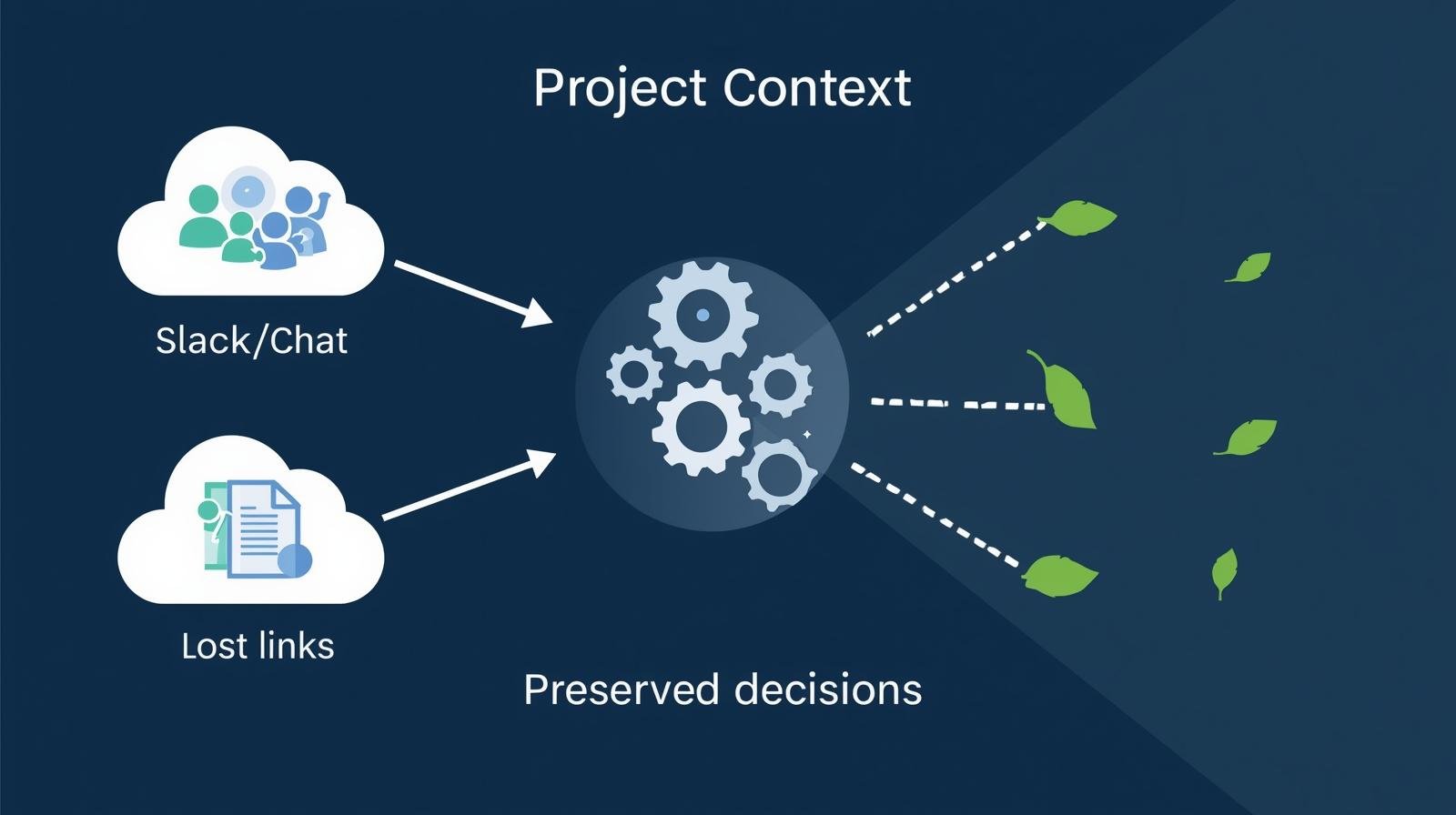The Digital Memory Hole: Are Your Discussions Disappearing?
- Kamal

Have you ever clicked a link in an old task, document, or project brief, hoping to find crucial context, only to be met with… nothing? A dead link, a permission error, or an endless scroll through thousands of chat messages that lead nowhere?
Welcome to the Digital Memory Hole. You know the feeling, hunting for that one chat, email, or document, only to find it’s gone, buried, or locked behind permissions. Every day, little pieces of your team’s hard work quietly disappear, and with them, context, insights, and the lessons that could have made life easier. And the truth is… it’s happening in your company right now.
We live in an age of constant communication. We deliberate, decide, and document across a variety of platforms, Slack, Google Chat, Teams, Jira, Asana, Confluence, internal wikis, and more. Each platform is excellent at capturing the moment of discussion but often falls short at preserving its lasting context.
The core problem? We rely too much on links.
“See the discussion on Slack,” we write. “The rationale is in that Google Chat thread,” we link. While convenient in the moment, these fleeting references often turn into digital quicksand over time.
The "Link Rot" Epidemic: Why Your Crucial Context is Vanishing
Imagine an architect designing a building. Instead of writing down the structural specifications, they just point to a napkin sketch from a meeting six months ago. Unthinkable, right? Yet in the digital world, this is exactly what we do, every single day.
Here's why relying solely on links to internal discussions is a ticking time bomb:
- Chat Overload: Discussions get buried under hundreds, if not thousands, of new messages. Finding that one critical decision from three months ago is like finding a needle in a digital haystack.
- Link Instability: Platform updates, team reorganizations, or even just the sheer volume of new content can make direct message links unreliable or difficult to access.
- Permission Hell: Team members change roles, leave the company, or simply aren't in the original channel. Suddenly, they can't access the "context" you linked, rendering your documentation useless.
- No Single Source of Truth: Decisions made in chat are separated from the tasks or documents they directly impact, creating fragmented knowledge.
The result? Wasted time hunting for information, re-asking questions, re-making decisions, and risking errors because the original rationale has been lost.
Depiction is Not Endorsement: Our Approach to Preserving Context
At Kafkai, we believe that Depiction is Not Endorsement. This isn't about promoting verbose chat logs; it's about ensuring that critical information is depicted (recorded) where it's needed, irrespective of its origin. A task description is where the outcome of a discussion should reside, not just a pointer to the discussion itself.
This isn't about copy-pasting entire chat transcripts, that would be messy and unhelpful. Instead, it's about curated redundancy: strategically embedding the essence of a discussion directly into the project management system, task description, or documentation where it truly belongs.
The Solution: Curated Redundancy – How to Future-Proof Your Decisions
Here’s a practical guide to stopping the digital memory hole in its tracks:
- Quote the Core Decision: If a critical decision or approval happens in chat, quote the exact message directly into your task or document.
- Bad: "API timeout discussed in Slack."
- Good: "API timeout set to 5 seconds. (Context from Slack: 'Yes, let's set the timeout to 5s, as discussed in the thread.')"
- Summarize the Rationale: Briefly explain why a decision was made. This doesn't need to be long, just enough for future-you (or a new team member) to understand the background.
- Bad: "Decided against Feature X."
- Good: "Decided against Feature X due to performance concerns. (Context Summary): 'Initial tests showed high latency, and further analysis indicated it would impact our $200ms$ requirement.'"
-
Always Provide the Permalink (Still!): Even with copied context, always include the direct link to the original chat message or thread. This allows for deeper dives if absolutely necessary, without making it mandatory for basic understanding.
-
Leverage Integrations: Many tools (Slack/Jira, Google Chat/Asana) allow you to "save messages to task" or "create task from message." Use these! They often automatically copy relevant text, creating that valuable redundancy.
-
Encourage Threading: Foster a culture of using threads in chat. A discussion contained in a thread is far easier to follow and link to than one scattered across a main channel.
Join the Discussion: What Are Your Thoughts?
This challenge isn't unique to us. Every team, every company grapples with the fleeting nature of digital conversations.
- What are your biggest pain points with lost context?
- How does your team currently try to bridge the gap between ephemeral chat and lasting documentation?
- Do you think "curated redundancy" is a viable solution, or does it introduce too much overhead?
Share your experiences and insights in your social platform and mention us! Let's collectively build better habits to ensure our valuable discussions don't simply vanish into the digital memory hole.